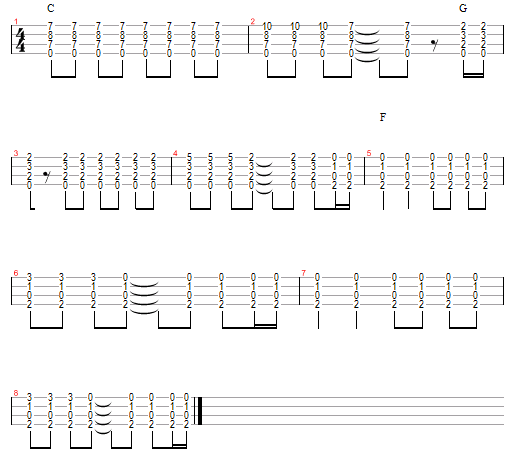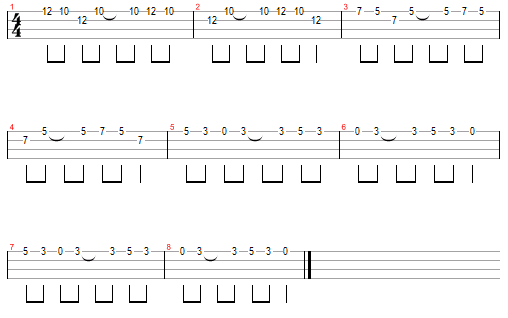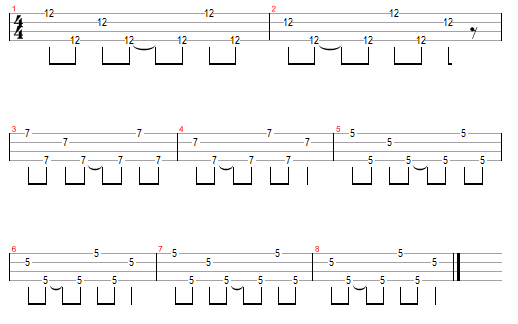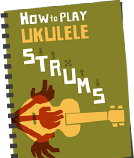New videos from the Corner Laughers, GUGUG, The Sweet Hollywiians’ Tomotaka Matsui on lap steel ukulele and plenty more. Read the rest of this entry »
MGM has the latest batch of Flea and Fluke ukuleles: Bamboo Fluke, Tie-Dye Fluke, Denim Flea, Camp Flea.
Fender Ukuleles turn up on eBay UK.
Some serious vintage charm to this Dobro Cyclops ukulele.
One of the Collings Guitars ukuleles cropped up on eBay.
Not often you see RISA ukuleles on eBay in the US but there are a few on there right now.
Ukulele photo of the week.
Jon Snow learns to love the Ukulele Orchestra of Great Britain (but can’t grasp the concept that there being no guitarist in the band).
Download a whole load of Garfunkel and Oates (Kate Micucci and Riki Lindhome). In the ‘Where are they now?’ file, Michael Barreto Hindert of The Bravery played a couple of songs on his ukulele for East Village Radio (uke songs at 35 and 44 minutes in the show). Popwreckening has Julia Nunes doing Mr Brightside.
Phase Two of the Ukulele Project needs your help.
Le Soir Sessions from Vetiver and O’Death.
WIUO/Kings of Leon – The Bucket (Chords)
An excellent choice of song for any ukulele group: dead easy chords and plenty of widdling for the flash Harrys.
Megan’s intro is based on the chords switching between the major and the 5 chord:
The twiddly bit that comes after that, and crops up a few times in the song, goes like this:
Or, if you want to play it fingerstyle, you can play it like this:
And there’s the little inbetweeny bit in the chorus:
Buy The Heartache EP

Ukulele groups, clubs and orchestras seem to be springing up all over the place at the moment. But if you’re setting up a ukulele group where do you start? I asked a number of people that have done just that to find out.
The experts:
Andy of Hull Ukulele Group
Corrie of Brockley Ukulele Group
Jimmy of Cowlitz Ukulele Association
John of Edinburgh’s Monday Ukearist
Tony of Ukuhooley Ireland
Mike of Kiwi Ukulele
Who’s Going to Join?
Andy: The first thing you need to do is think about who you want to come to your group and what you want the club to do/play. For example, I want my group to be cool and contemporary like the Wellington International Ukulele Orchestra, rather than just be the George Formby Appreciation Society.
Are beginners welcome? Really? Do you really want to spend your precious uke club time teaching C to people with badly out of tune rainbow Mahalos? Equally, everyone has to start somewhere, and a beginner probably has more incentive to continue coming than someone who can already play. Also, if beginners aren’t welcome, there might not be anyone else in your area who can play?
John: One of the primary things that I wanted to do with the Monday Ukearist was keep it beginner friendly so for the first couple of session we chose easy songs and have devoted the first hour to teaching. Initially we have stuck to songs in the key of C and with each new song learnt adding one or maybe two chords to those already learnt. My favourite song for teaching first is slightly simplified version of Get Back by the beatles which uses C, C7 and F. You can usually get complete beginners playing a passable rendition of this in half an hour and they’re generally amazed that they can actually play a recognisable song so quickly, hopefully that will get them hooked! The teaching has simply cover basic strumming with pointer finger, fingering chords and moving between them and holding the uke. Songs where the chord changes aren’t too rapid are good for starters too to give folk a chance to form the chord and strum it a bit before having to change as those who haven’t held a uke before will inevitably be a bit slow first off. Song sheets that show the chord changes above the lyrics are really good for beginners – like on the Dr Uke site. So first tip – keep it beginner friendly.
Jimmy: Many of our students and club members are folks that used to play the guitar or people who bought a ukulele while on vacation in Hawaii with good intentions of learning and then lost interest because they didn’t have anyone to play with.
Mike: I think you have to decide early if you want the group to be a drop-in happy beginner-friendly strumalong, or if you want to eventually perform somewhere (in which case it’s worth practising arrangements with percussion and bass). Having a performance goal can give the group some direction after the first few meetings. It’s possible to have a beginner session for the first hour then switch to the tricky stuff.
Local Advertising
Corrie: I work in a coffee shop in Brockley, South East London where I’d noticed a few people sheeplishly picking out tunes on my toy uke then scurrying out. My lovely boss suggested I use the coffee shop for a jam session so I put up a notice inviting the closet ukulele players of Brockley to join me on Sunday. Which was all ridiculously easy.
Jimmy: Play in public. Most towns have a Saturday Market. Play and let people know you want to start a club. Go to some senior centers and entertain the folks, or play for church functions, work, picnics, etc. While you’re there advertise how easy it is to learn, that you’ll teach people to play, and would like to start a ukulele club. Give a lesson while you’re there to spark interest.
Andy: Make a poster. You don’t have to be a design whiz to do this, and you don’t even need fancy pants software. Here’s a tip:- open a new document in MS PowerPoint, go to ‘page setup’ and change ‘slides sized for’ dropdown to ‘A4 paper’, then change the page orientation to portrait. Then create ‘text boxes’ to stick your words in, pick a nice font, and move it all around until it looks good. – Hey presto! Instant poster!
Make sure your advert gives people an idea of what to expect from the club. Something with George Formby or Tiny Tim on it is going to give out a very different message to a picture of Eddie Vedder playing a uke.
Make sure you put contact details on the poster. I set up a google email account rather than give out a telephone number. Call me old fashioned but I didn’t fancy drunken people screaming ‘When in cleaning windows’ down the phone at 3 o’clock in the morning.
Even if you don’t have a time/date/venue sorted out you can still stick up an advert to create some interest. I put up a couple of posters in a local bar that just said ‘GOT UKE?’ a short explanation of what I wanted to do, and an email address.
Several people responded within days.
Finally, I’ll let you into a secret here. Journalists (like most people who have to work for a living) are quite lazy. They are constantly searching for stories and information to fill column inches or broadcast time. If you contact them and tell them about your club, you’ll be effectively doing their job for them – and they’ll love you forever!
Using the Net
Andy: If you are in the UK, post an ad on your local Gumtree site, or the classified website linked to your local paper (most have them). If you are American, then post on Craigslist or such like.
Set up a Facebook group. Advertise this on other Facebook groups about your area. You’re setting up a Ukulele club in Sheffield? Let people in the ‘I love Sheffield’ group know about it.
Join your local Freecycle group – these very often have Freecycle café/chat groups attached to them that you can advertise on. Another idea I had, (that I didn’t have to use) was to offer up one of my old (working) ukuleles on Freecycle. Not only are you ‘spreading the love’ but you’re instantly going to get a response from people who are potentially interested in ukuleles.
Post in the ‘Clubs’ section on ukulele cosmos. It might not be seen by anyone local, but their mate in a different city might see it, and tell them about it. You can also get help & advice from successful clubs on there, and find out what other people have done in the past.
Set up a website for the club, or blog about what you are planning to do. Mention your club as often as possible, and include the name of your club/website in your signature on forums, or when you respond to posts on other blogs. You’ll be amazed how much traffic you can generate this way.
Ultimately, what you want is for someone to be able to google the name of your Town/City and ‘Ukulele’ and for them to find you. If you can get to this stage, you’ve cracked it! (Woodshed: If you’ve done that and are still having problems let me know and I’ll help you out – unless you’re in Wellington or New York).
John: We have done very little advertising, just an advert on gumtree, posts on a few ukulele forums and a website. It seems that these days most people look to the web first to find information. We may put up posters in music shops too at some point but currently we have a very healthy number of people coming along. I set the website up at wordpress.com where you can free hosting and quickly set up a very well featured website, great when you need something up quickly.
Tony: When I fell in love with the uke the year before, I started looking for a uke get together so that I could begin to develop playing skills but there was nothing like that in Ireland. I discovered the various uke forums, ie, Ukehunt, the Cosmos, FMM, eZe-folk, Ukulele Underground and I looked through their memberships lists for uke players in Ireland and wrote to them all (initially about 20) and suggested the notion of meeting up to play the Uke. I also put up a posting on all of the forums. I was overwhelmed by the very positive response and co-incidentally “Cool Hand Uke” aka: Dan Scanlan the well known Californian Uke veteran (he’ll kill me for that!) and fantastic teacher had written to say he would be in Dublin in August so we had our initial meetup in a nice large room in a house overlooking the sea on Saturday August 9th last year. Dan gave a great workshop on the day and it got us off to a great start.
Charlie Connelly (late of the parish of London and the “Cosmos” is now resident in Dublin and he is the “official chronicler” of our activities and anyone who is interested can have a look at his excellent blog Ukulele Ireland.
Mike: Get a website where you can post PDFs of the songs, or links to them. Blogging software is great for this. Also consider an actual songbook/ringbinder you can give to newcomers. One group I know uses PowerPoint.
Venue
John: I think it’s important to have a semi-private space to conduct the club, be it a pub function room, village hall etc. I think a lot of beginners would be put off if it was in a public bar. We have our group in a language school, the manager of which is a keen uker and offered up the space for free. If you are hosting a club on a ‘dead’ night of the week a lot of pubs or social clubs will be pleased to have you in as it’s extra custom for them. I’ve heard the working mens clubs and the like can be good places to try for a venue. Having somewhere easily accessible is really important too. I did actually start another uke club in a pub about 45 minutes drive from central Edinburgh that on it’s busiest night had four people (including myself and the other organiser) and a bloke who played the spoons! The contrast to Monday Ukearist couldn’t be more marked!
Mike: One group I was in was supported by the local music shop and met there after hours; they let walk-ins use thier cheap ukuleles, tuners, and music stands, and I’m sure they got some business out of it.
Jimmy: If your local parks and recreation dept. has programs such as this one, check with the activities director and see if you can start a ukulele class. Once you have the interest then you can start your club like we did.
My grandson was attending a children’s play day through our local parks and recreation dept. I noticed there were classes like yoga, dance, sewing, etc., and guitar. I spoke to my friend and asked him if he thought we could start a ukulele class and then start our own ukulele club. We contacted the parks and rec. dept, the program director loved our idea, and we started our classes three months later.
Song Selection
Tony: It’s a pretty democratic affair and everyone is involved in the decision making. We take it in turns to lead the group for the day and introduce about two or three new songs at each meeting. Everyone is encouraged to contribute but there is no pressure. I think the greatest strength for us has been the acceptance of uke players of all abilities and a willingness to help and support each others playng and development.
Corrie: We’ve always played covers, the further removed generically from George Formby the better (Though Arctic Monkeys in the style of George Formby was an exception). Some ukers being more adamant than others (Myself included) we got a bit wary that some members were feeling a bit left out we started nominating a different person each week to bring song suggestions: the rules being there are no rules. Nothing is mocked, everything is attempted, from Bonnie Tyler to Bauhaus. And if enough of us are feeling it then it’s in. These days everyone trusts each other enough to bring songs to the table regularly and I’ve met people with awesome taste in music, it’s been educational.
Mike: Repertoire is always a sore point. I love the Brockley Ukulele Group’s taste in music, but it wouldn’t suit some of my uke group. There’s plenty of room for diversity, so core members should feel happy stating the sort of thing they’re interested in playing, and if other folks don’t like it they can start their own ensemble. I would love some method of voting on repertoire without hurting anyone’s feelings…
Regularity
John: When starting off it is probably best not to go weekly as you may end up spreading a small number of ukers over many nights, it would be better to concentrate them in fewer nights so I would suggest fortnightly or monthly. Ours is fortnightly, but such has been teh success so far I am currently looking for a beer-serving venue to take it weekly so that we’ll have alternating one week at the language school and one week at a pub. I envisage that the pub sessions will be less beginner focussed and more about just having a jam with friends. I think this will work well and give a nice balance of focus across the two venues. I don’t want to get into separating people into beginners and experienced, I would rather keep everyone together as far as possible.
Tony: We meet on the second Saturday of each month.
Keeping Going
Corrie: About 5 people showed up to the first meet-up. Attendance was pretty erratic for the the first couple of months, ranging from 3 to 9 ukes, sometimes timid, sometimes raging. I guess it was down to keeping the meetings consistent, having them every week at the same time regardless of how many could show, how hot or cold it was outside (Or inside for that matter), how tired/hung over you were etc . Once people felt assured that you weren’t going anywhere then people got more committed and we gradually came to have 6 or 7 regular players, with several additional ukers who play when they can.
Rules
Corrie: No Guitars, No Guitars, No Guitars.
Andy: No Banjoleles, No Hawaiian Chords, No E-Major Chords. By saying no banjoleles I wanted to subtly distance myself from George Formby associations. The no Hawaiian & no E-majors bit I stole from Kiwi Ukulele Mike, mainly because I think its funny! (and if the East Yorkshire Polynesian community has a problem with that, tough!)
If It’s Not Fun, Don’t Do It
Corrie: After a ropey Halloween gig, including most of the classics, there was a debriefing/drinking session in which we admitted that it wasn’t that we didn’t like the songs, but we were playing what we thought we should play instead of just enjoying ourselves with songs which compelled us to laugh, stare whistfully or rock out, which was why people came to see us, and why we met-up in the first place.
Tony: I think all of our members would say its been just brilliant meeting up with all these other uke enthusiasts and making new friends. The age profile is as wide as its possible to be and its been wonderful to see how much fun this magic little instrument has given us all.
John: We all go for a beer afterwards too – that bit is important!
WIUO/Outkast – Hey Ya (Chords)
Hey Ya was the first song I – and I suspect most people here – heard from the Wellington International Ukulele Orchestra. It’s coming up on half a million YouTube views and over 500 comments – most of them saying, “Is that that dude off of Flight of the Conchords? Awesome!”
The easiest way I’ve found of playing the chords is to play the D 2225 to make it an easy slide up to 4447 for the dreaded E chord.
Suggested Strumming Pattern
For most of the chords you can use this pattern:
d – d u – u d –
But there is a time signature change in there. The D chord is one bar of 2/4. So just do two down strums for that chord. Or you could really cheat and play a baritone like that dude off of Flight of the Conchords.
Twiddly Bit
Every uke group song needs a twiddly bit in to keep the show offs in the band happy.
First part of the phrase played a bar later than in the original.
I’m way too lazy to move up and down the neck, so I prefer to play it like this:
Visit ukulele.co.nz

If I had to pick one group to represent where the ukulele scene is right now, I’d go with the Wellington International Ukulele Orchestra: a big bunch of sexy people singing songs with huge grins on their faces. In honour of that fact, this week is dedicated to the WIUO kicking off with and interview with three of the band: Age Pryor, Gemma Gracewood and Megan Hosking.
With your EPs and shows selling by the barrow-load over there, when are you going international?
AGE: We’re working on it – currently in development of tour plans for USA in either, or both, 2009 and 2010, and also getting excited about somehow blagging our way over to Japan. Know any friendly Japanese ukulele enthusiasts we can stay with? With room for 12 people on their couch? Those little apartments weren’t designed for touring Ukulele Orchestras, eh…
What’s your role in the orchestra?
GEMMA: Well, first of all, everybody apart from Dan plays the ukulele. Dan plays the double bass. He describes himself as ‘the anchor that keeps 11 helium balloons from floating off’. We’re not sure whether that’s an insult.
Musically we’ve organically developed various roles by virtue of our technical experience and/or our personalities… Age really is our band leader, Nigel fine-tunes the vocal arrangements, Andy is our default lead singer (when we haven’t figured out who should sing a song yet), Sam’s the left-hander, Steve shreds up the solos, Francis strikes perfect rhythms, Megan gets to shout ‘1, 2, 3, 4’, Carmel dances and does a nice line in 50s-style songs, Bek is our punk rock star, I deliver a lot of unnecessary trivia and Bret services the ‘international’ part of our name.
We also assign ‘ministerial’ roles when we go on tour because you can imagine that it’s like herding cats. So we’ll have a Minister of Well-being (makes sure we’re eating and sleeping), a Minister of Hi-Jinks (makes sure we’re having fun), a Minister of Hot Licks (makes sure we’re practicing new tricks) and so on. The people in those roles rotate on each tour.
What makes for a good ukulele cover?
AGE: Anything goes. In our group we tend to favour songs with tasty vocal harmonies, and catchy numbers that are hip with the kids (or used to be hip with the kids 40 years ago). Sometimes you go for the element of surprise (eg a heavy Metallica number) and other times the classics (eg I Did It My Way), but ultimately, it’s about how the tune and the performer fit together.
You’ve had some high profile collaborations. Who would you most like to jam with?
MEGAN: Woah there. It’s a long list. Basically, all the international living legends whose songs we have had the privilege of playing and/or recording. Y’know, Cohen, Wonder, the Followill Brothers, Andre 3000… And since this is a wish list, some of the not-so-living legends like Lennon, Kermit, Cash…
What’s your favourite song to cover on the uke?
MEGAN: Just one? That’s pretty unfair. My favourite cover is Toto’s ‘Africa’, which Age, Nigel and Andy do with a few little added extras from the rest of us. Including a gong, African thumb piano, and soul claps. (So, no, we are not a purist Ukulele Orchestra). I am not sure if we have crossed the line into Stone Soup territory, as these elements are still the garnish. It’s when we start bringing in tubas, timpani drums and violins that I will start to worry.)
What’s the ukulele scene in New Zealand like? Any other NZ ukulele acts we should be checking out?
GEMMA: The absolute godfathers of the contemporary scene are the Big Muffin Serious Band guys (who also go under The Serious Ukulele Ensemble moniker). They paved the way for us. They hail from Hamilton, a city that services the farmlands south of Auckland. Their outfits are outrageous and they’re a brilliant act.
And I would have said they’re not particularly serious, until I heard TSUE’s newest album ‘Mostly Harmless’. It’s all instrumental and it has some seriously incredible covers such as ‘Albatross’ and ‘Paint it Black’. They’ve got a MySpace site.
MEGAN: It’s true that the uke is having a bit of a revival Down Under and it has made its way onto loads of new pop albums around here – like Tim Guy‘s latest album.
But perhaps more importantly, the ukulele seems to have been one of the best selling Christmas presents last year, and so you will find one in many houses in New Zealand (in various states of being ‘in tune’).
The tricky thing is converting the ‘having a uke’ to ‘playing the uke’. The ukulele is being taught in many New Zealand schools and ukulele groups are sprouting up everywhere. And we are doing our very best to grow the scene by hosting winter workshops which have spawned several new orchestras and bands.
All of this equates to more people playing and singing together – because with 3 chords under their belt, they can. And that’s what we love about it.
What is it with islands and the ukulele?
GEMMA: I dunno! Maybe because it’s hot, it’s just easier to play something with fewer strings? Maybe the slack-key styles perfectly suit the laid-back feel on the islands? I like to think it’s something to do with minor key tunes sounding prettier and less plaintive on the uke, so you can trick people by making sad songs sound happy under a tropical palm tree (and we have so many of those here in Wellington).
The thing about New Zealand is that in the 1940s and 50s we had a lot of dancehall big bands that were led by Pacific Islanders – Bill Wolfgramm, Bill Sevesi – and ukuleles were always a feature of their bands. So the four-string has pervaded our pop music from fairly early on. In fact, it appeared in NZ’s first ‘official’ pop song, a wartime classic called ‘Blue Smoke’, way back in 1949. We’ve done our own recording of that song – it’s coming out this year sometime. Well, that’s a rumour I just started.
What advice would you have for anyone starting up a ukulele orchestra?
GEMMA: Don’t hesitate, do it! Start by playing your favourite songs. Try to write your own songs (we’re giving it a go). Meet often. Set goals. Think of a shorter name for your orchestra than we did. Find a local café that will let you practice in it – I only got good by having to play in front of strangers. Play everywhere, all the time.
Do you ever have band arguments? How do you resolve them?
AGE: We never argue. It’s un-ukulele-like. Occasionally we have different points of view, but these all get sorted out on the bandstand. It’s about the walking, not the talking. Or so I’m told.
What can we expect from you this year? Any new releases planned?
GEMMA: Yes, we have a new release planned! We recorded at Neil Finn’s Roundhead Studios in late 2008 so we need to do something with those songs. Other than that, more gigs, more tours, more fruity vocal harmonies to work on… More fun, generally. That’s our bottom line – when it stops being fun, that’s when we stop. We haven’t stopped yet.
Friend up The Wellington International Ukulele Orchestra on Myspace and buy their EPs on Amplifier
Yurima – River Flows in You (Tab)
I’ve done plenty of TV, book and game themes but I think this is the first book theme I’ve done. There seems to be a fair bit of confusion about what constitutes Bella’s/Edward’s Lullaby which I got caught up in. When I was working it out, as a very cheap Christmas present for a friend, I thought I was working out the song from the film. But it turns out this version is in the film and Yiruma’s River Flows In You was decided to be the theme by a bunch of fans. And I think the fans got it right. River Flows in You has a very sweet catchy melody. And the official piece, well, it’s a bit shit.
I try not to feature two videos from the same act in a week, so I’m fudging it by having one video from Rocky and Balls and one from just Rocky or Balls (I give it about 3 weeks until they’re on Boing Boing). Along side them are plenty of old friends (including GUGUG, Jake Wildwood, the Bobby McGees and Rod Thomas doing a mashup of Same Old Lines and The Sign) and new faces (including Olivier Ruldry with some seriously smooth picking).
And I wanted to post this video because those two are superstars. But, well, I really hope she thinks she’s singing about lollipops. Read the rest of this entry »
The Germans seem to be heading the field when it comes to great looking electric ukes. As well as RISA, there are these Rocktile FRAME ukuleles. They obviously take a few design cues from Eleuke, but end up looking more stylish. And on the subject or RISA, if you’re a fan of the ‘melted telecaster’ shape there’s this acoustic version. Which utilizes the Fluke headstock shape to have geared tuners without the ears.
Out of season it may be, but it’s not often you get a chance to pick up a Black Bear Christmas Bell ukulele.
A banjolele, “that once belonged to The famouse Pete Waterman.” He took it in to be repaired and never bothered picking it up again. Apparently.
Another new wood for the uke with Kanile’a using macassar wood. Certainly looks great.
A Spanish ukulele with an Isle of Man inlay*. You’d have to cover this on it.
If you’re bored of the standard ukulele hangers, check out this Tiki uke hanger set.
Kitsch-tastic hula girl print on this ukulele.
* According to Wikipedia, the same symbol is used in Galicia. But that’s the opposite end of Spain to Valencia – where the uke was made – so the mystery remains.








